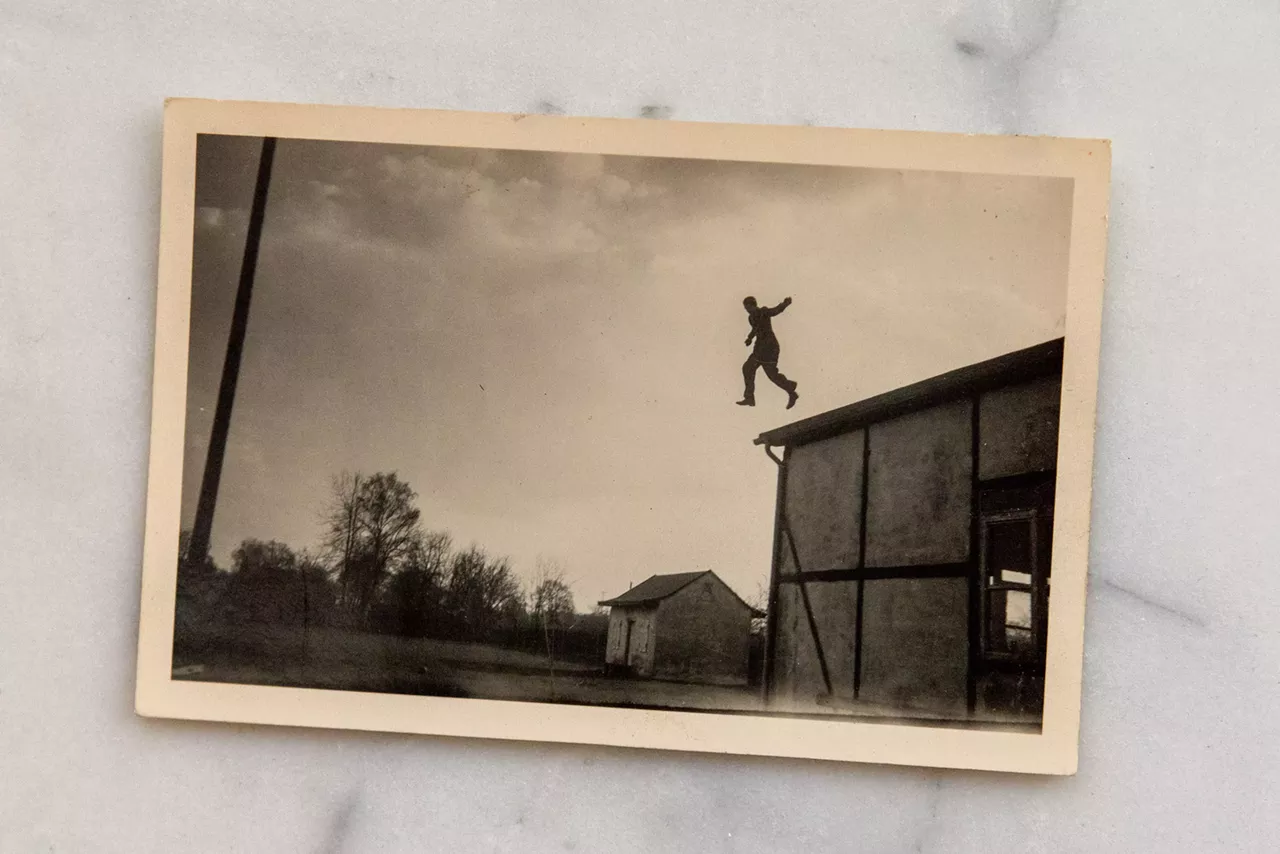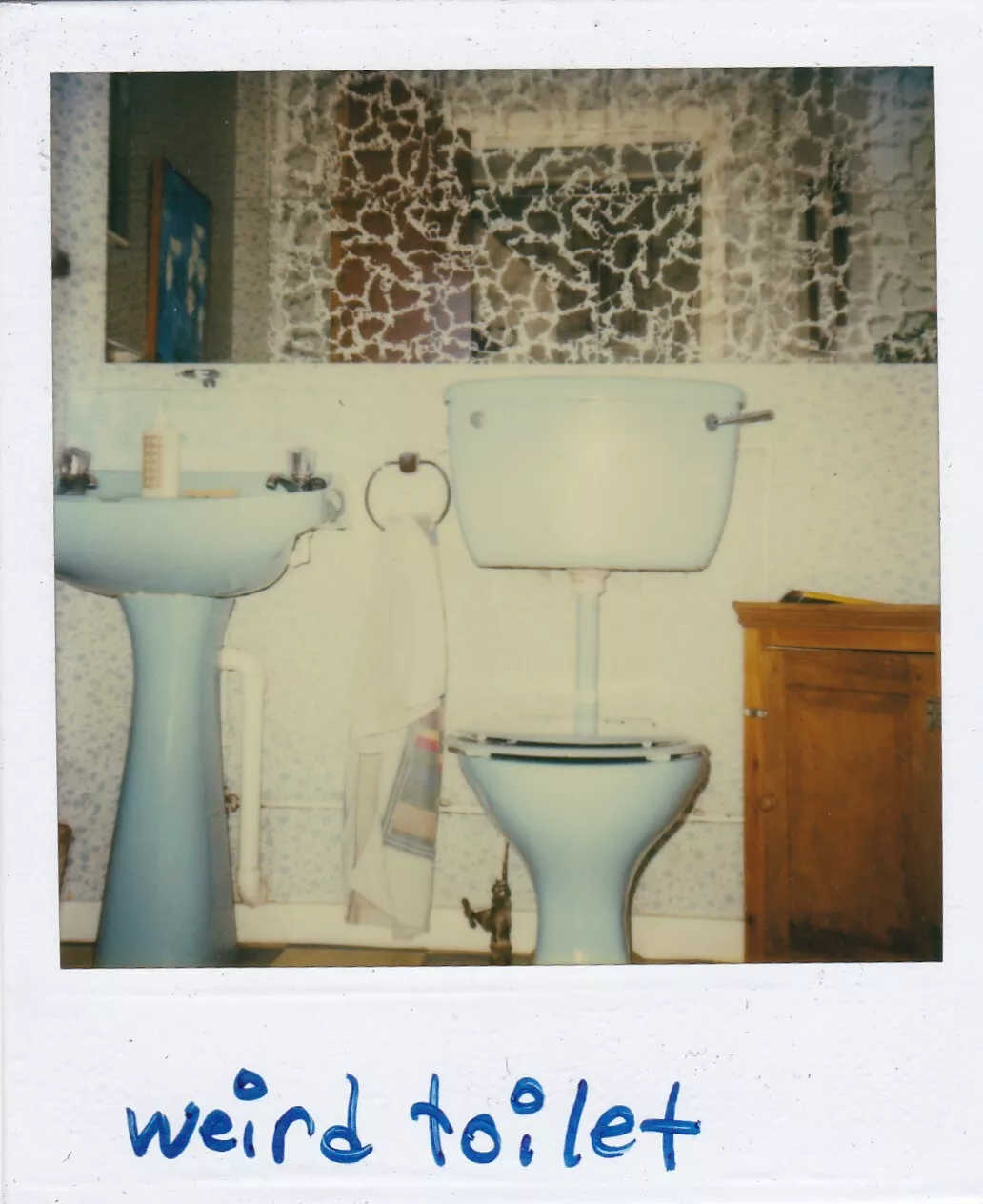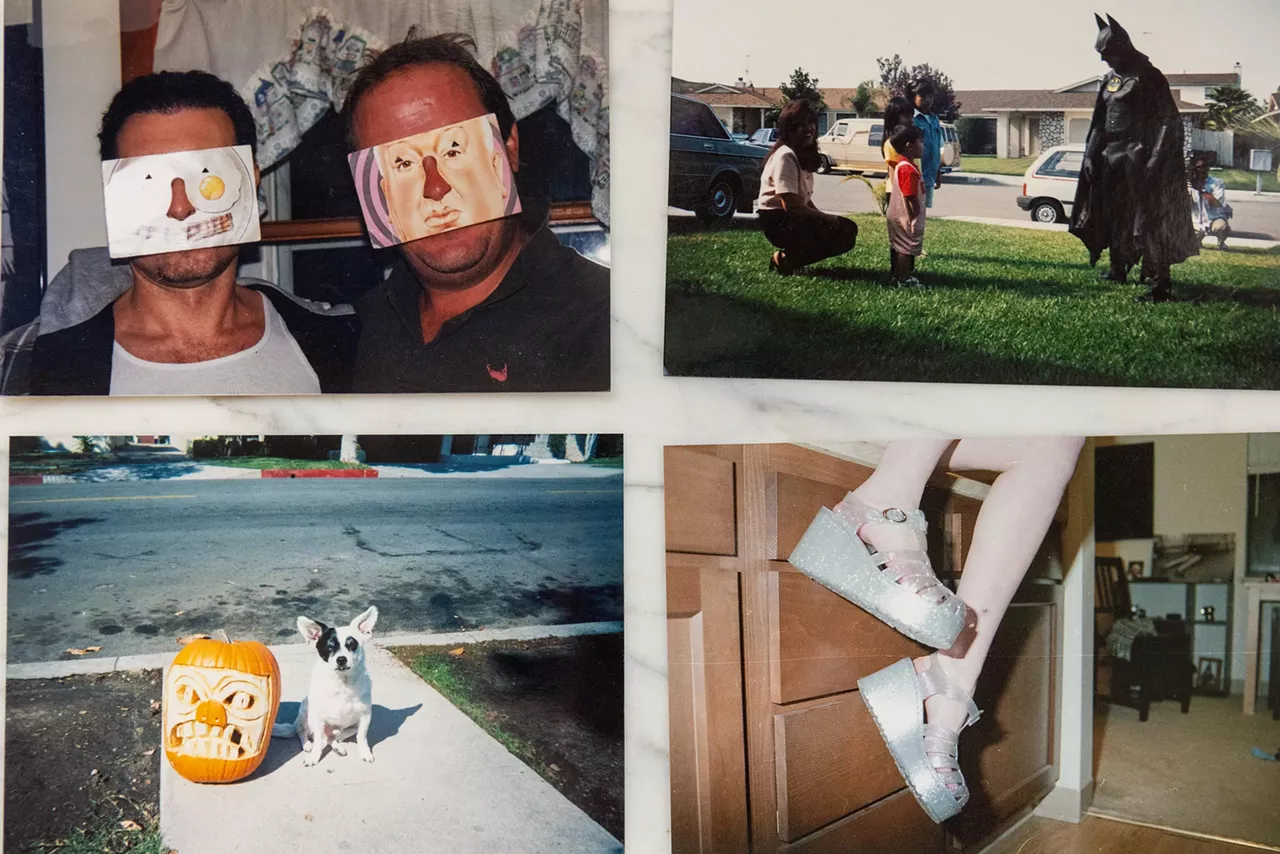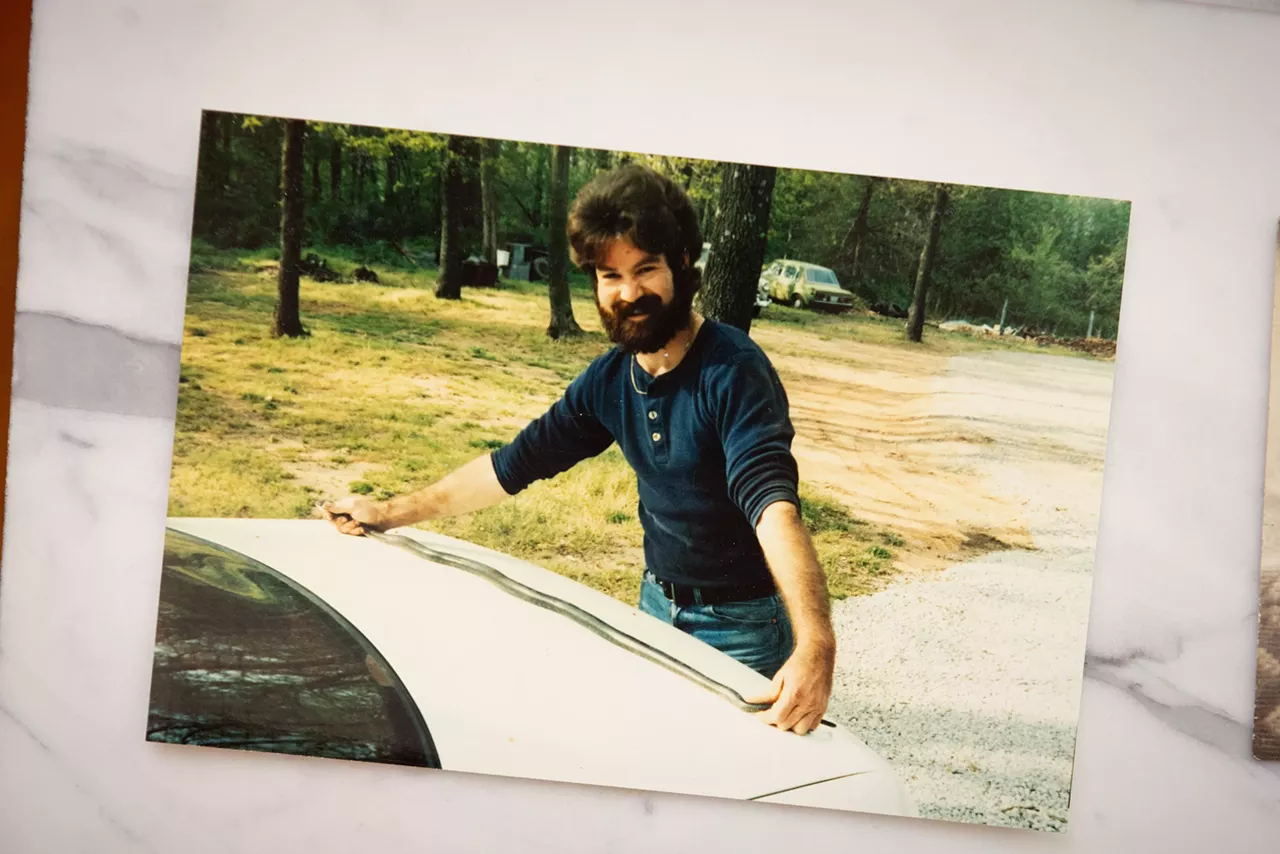Photos by Billie Winter
We’ve all experienced flipping through a bin of old photos at a garage sale, vintage store, or flea market. Full of curiosity, we peek into the past lives of people we’ll never meet. And sometimes we hit gold—an awkward family photo, an image of a place we once loved that no longer exists, or a striking and confusing shot of a human head montaged over a dog’s body—and we become enamored with the stories behind them that we’ll likely never know. For Seattle collector Robert E. Jackson, snapshots are less about nostalgia or strangeness-for-strangeness’ sake. They’re about the magic of happenstance and photographs as physical, tactile, IRL objects.
Jackson’s growing collection is approximately 20,000 vintage photos, 15,000 of which are funny, strange, and uncanny snapshots that span the 20th century, from photography’s early days (he estimates that the oldest photograph in his collection is from the 1860s) to early 2000s 4×6” drugstore prints. Jackson is attracted to images that have a unique punch that he calls “pure photography”—snapshots full of perfect, mysterious accidents that elevate them to fine art, where context is often irrelevant.
Over the years, his unique and discerning eye and rapidly growing collection—which started in the late 1990s while he was working as a financial analyst at Washington Mutual—have been the subject of several acclaimed exhibitions at Pace Gallery, the National Gallery, the Amon Carter Museum, the Bellevue Arts Museum, and Seattle’s Photographic Center Northwest. He has also published several books and catalogs and has received wide press and acclaim, most notably in an essay by John Updike for the New Yorker. Some images even inspired characters for Hollywood films.
Jackson graciously invited me to his Capitol Hill apartment to explore his collection’s most curious gems, and the scene isn’t what you might imagine. He isn’t some hoarder swimming in a mess of thousands of old photos. His apartment is immaculate, yet welcoming—walls adorned with a mix of snapshots and art he’s collected over the years. Some of my favorites include collages by Seattle artist Joe Rudko and embroidery by Warren Munzel. Jackson keeps most of his photographs organized in small photo albums on shelves in a closet adjacent to his bedroom, some organized by genre or period and others with some ambiguity. And while he generally knows where everything is, there’s often a feeling of magical discovery, as we stumble upon an image that feels fresh for the first time.
Let’s go way back to your early days of collecting. Can you remember the first photo that you collected or came across?
I started collecting in 1997. I can’t exactly remember the first photo I bought, and it probably wasn’t that interesting, but the earliest ones I can find are these two, which I bought around 1998 or 1999.
They’re still good enough to stay in my collection after 25 years. And the reason is that this is very odd.

This photo of the man jumping off the rooftop [above] is an earlier image from my collection, which continues to be one of my favorites. I realize I am a formalist when it comes to images I am drawn to. I like strong, simple compositions which emotionally and visually hit me in the gut. There is a starkness and a narrative mystery to it that really speaks to me.
This is an early acquisition related to a theme which I didn’t know much about at the time. It deals with the photographer’s shadow being found in the photo. I love this photo [below] as you can see the head of the photographer at the bottom of the photo in his bowler hat. I liked the simplicity and starkness of the composition with the marvelous curve of the lamp post and the straight line on the ground which divides the photographer from the actual subject of the photo.

Do you remember where you found these photos?
I bought these at some store, because I wasn’t on eBay yet. I was only buying from people in person, and then I started to go to shows, where they would have [photos] on a table or bins, and you could go through them. I [also] went to antique stores—there were some in the city that sold vernacular photography, so I would go there and look every week.
Did you search with anything in mind?
I didn’t search by theme—just wanted small photos. And I didn’t want anything that dealt with specific historical subjects. I’ve never really been interested in the narrative aspect of the photo or where and when it was taken. I was just looking for interesting things.
As your collection grew, when did you start thinking about showing it to others or exhibiting it?
In 1998, SFMOMA had a snapshot exhibition, and I flew there to see it. I had about 1,000 to 2,000 in my collection, and I wanted to understand what was considered “good enough” to go on the walls of a museum. I was gratified to find that what I was collecting seemed to be in line with what a “good” snapshot was.
This must have been validating!
I was going at it alone—it was before social media. There weren’t many widely published snapshot books, exhibitions, or lectures at the time. So I was buying in a vacuum. Going to the show validated my interest, my eye, and what I was doing.
What do you think makes a “good” snapshot—one that’s worthy of the walls?
It’s all very subjective because I’m not looking for photos based on subject matter. For example, something military or from a specific historical period, even though many collectors are, and would consider it a “good photograph.” I’m looking for something aesthetically oriented—snapshots from everyday people that remind me of art photography.

What art photographers come to mind most?
Diane Arbus, William Eggleston, Robert Frank, Garry Winogrand—they were all affected by the snapshot aesthetic. So, many collectors are looking for things that remind us of a famous photograph and the quality and that kind of image. What we’re looking for is often something mysterious, like a hidden face. Anything that’s odd and unsettling.
Do you feel like what you’re looking for has changed over the years?
Today, I’m more interested in uncommon things rather than just amazing images. When I had the Art of the American Snapshot show at the National Gallery in 2007, we were trying to show some of the best of the best of the kinds of snapshots that would be like “masterpieces.” Things that were so defining, wonderful, beautiful, artistic, and odd that they would transcend being a snapshot and become something else altogether.
I’ve become more interested in damaged photos. Also, photos that are strange, sometimes in bad taste—photos that stretch the limit of what one can find in the snapshot, and then the stuff that’s just purely like the most wonderful thing. So I started with a formal approach—the strength of the visual power of the photo, finding that hook.
For me, it’s not the subject, it’s the weird, beautifully damaged object itself. I just love it. I gravitate towards things that reflect what our life is like. I want moldy photos and fire-damaged photos—things that have stretched what a photograph is.
You’ve joked about how your collection is sometimes at 15,000 “more or less” because you’re buying and selling all the time.
Having a collection is like having a garden. You have to weed and cull it, because it’s never just about the number of photographs. It’s about the quality. It’s meaningless to say that I have 15,000. What’s important is whether those 15,000 are good. Do they work? If they don’t, they shouldn’t be in it. And sometimes it’ll be hard for me to take something out, but I find that the collection is richer and more cohesive if it’s smaller.
How do you decide it’s time to part with an image?
I decide it’s not strong enough. It has to hit me that I don’t like it as much.
When you are ready to part with an image, how do you decide what it’s worth?
I’ll often buy a group of photos just for a few that stand out. I might sell them for $5, $10, or $15. But stuff that’s already in my collection is more. If I don’t want to sell a photo, but someone expresses interest, I set a high price and will sell it if they say yes. I can’t be buried with this material.
Do you have any all-time favorites or images you’d never part with?
Probably this one. [Below] It’s a mounted photo. The photo is maybe 5×7” on a 10×8” cardboard mount. And it’s a mistake. Somehow, when it was printed, the chemicals reacted with the photos. It’s probably from the 1910s or the 1920s, and it got muddied. It’s magical, and there’s nothing else like it.

I also like things sometimes with unusual captions. Captions are always fun. [I like] this one [below], not because the photo’s so good, but because of what it says. Just Polaroids of toilets. The words make it so enigmatic and strange.

I’ve always been curious, do you look at Instagram snapshots as “vernacular” photography? Could there be a place for them in your collection?
I’m not interested, because I really want to collect photographs as objects. But I’m older and of a different mindset. A younger person might not be object-oriented in the same way, so they might actually start collecting what’s on the screen, make books of it, or just have their own digital file. But I’m not interested in doing that.
So, what era is the cutoff for you?
When vernacular photography stopped becoming a paper focus, around 2007, when the 4×6” drugstore prints slowed production.

The 4×6” has become a growing part of your collection. How did that come about?
It’s been undervalued, understudied, and underrepresented—it’s the last paper snapshot that existed. It was the largest format that a snapshot ever was commercially available for, for widespread consumption. It was more democratic, and there are more people of color in these images than in any other era. I thought it’d be interesting to investigate it, to understand what it tells you about the eye of the public at that time in America. I’ve been able to get about 400 photos that fit.

This one, the dead snake [above]! Something is so curious about his hair and his beard. It all has an odd feel together.
I look for things that feel realistic, because it’s [the] straight line, it’s the white. If [the car] was a different color, it wouldn’t have shown up. It has to hit me. And there’s a mystery to that.
You’ve gotten a ton of press about your collection; it’s been widely featured, exhibited, and published. And you just hit 11K followers on Instagram. You’ve shown at the National Gallery, Pace, Photographic Center Northwest, and the Bellevue Arts Museum. Has this changed how you think about your collection?
It’s nice to see the space around them—they seem more weighted and powerful. Then you start to think of how they relate to fine art photography because most art photography you see is framed. It’s wonderful.
Does the digital life they now have on Instagram and Facebook open up how you think about them, their lifespan, or their “object-ness”?
I’m surprised that certain images I like don’t get the response that others do. I’m often surprised when people find images on my Instagram and want to use them. One person wanted to use an image for college class projects.
A few of your images were featured in the 2011 Ransom Riggs book Miss Peregrine’s Home for Peculiar Children, right?
Some of those became actual people in the movie. I don’t know if the actual images were in the movie, but they were based on photos in my collection.
Do you still have those photos in your collection?
I own some from the book and sold the best ones to the author. This one is probably my weirdest, and is in the book. It’s a real photo postcard of a dog lounging in a studio, with a boy’s face montaged onto it [below]. This is in the book and might be mentioned in the movie. I won’t sell this photo because it’s probably the craziest image in my collection. It’s so wild, pre-digital manipulation. It’s disturbing.

You’ve also inspired and collaborated with artists, right? Didn’t Justin Duffus use one of your images for painting?
He does these paintings from square photos. I found a photo from my collection that I thought would make a great painting, tracked him down, and asked if he would do one [below]. We quickly became friends.

It’s been fascinating to see the power and warmth of the community you’re part of—whether it’s through other collectors around the country or artists like Joe Rudko and Rafael Soldi in Seattle. The simple act of collecting a snapshot has opened up so many warm connections.
I like to joke about the people I call “my competition”—people who also have wonderful collections are my friends. I have stayed at their houses. We talk on the phone, and I see them at shows. And then there’s the international part, too. I know people in London, in Paris, all through collecting. My strongest friends are people in the photo world. It’s also an area of being exposed to and becoming friends with people you might have no other commonality with.
Tell me about a recent purchase which you are excited about.
As I mentioned earlier, I love 4×6” color photos. I love them so much that I am hoping the next publication featuring my collection will be on such photos from my collection. What drew me to this recent acquisition was that it shows two men kissing [below]. This is in fact surprisingly a rather rare subject in snapshot photography. There are actually more images which exist of women kissing than that of men exhibiting such love. The specialness of the photo is not really in the beauty of how the photo was composed, but subject. I don’t really buy many photos simply for subject, but this celebration of emotion and male affection compelled me to purchase.

I love that! My final question, which might sound a bit cryptic, is: What do you see in the future?
For me, for collecting, or for you?
Ha! Collecting in general. What are you optimistic about?
Realistically, in 15 years, I might be gone. In the time that I have left, I want to have an exhibition with a collector that’s from another country, because nobody’s ever done something, a book or show, where you have a collection in the United States with somebody from another country.
I’d like to be a mentor to new collectors. Also, I want to branch out into other areas of collecting that aren’t even photographic. A lot of collectors I know are older, so there’s going to be a huge [transfer] of stuff going to auction in the next 20 years, and there aren’t that many new people around. So I don’t know what the world will be like for snapshots.

Follow Robert E. Jackson on Instagram at @robert_e._jackson.




